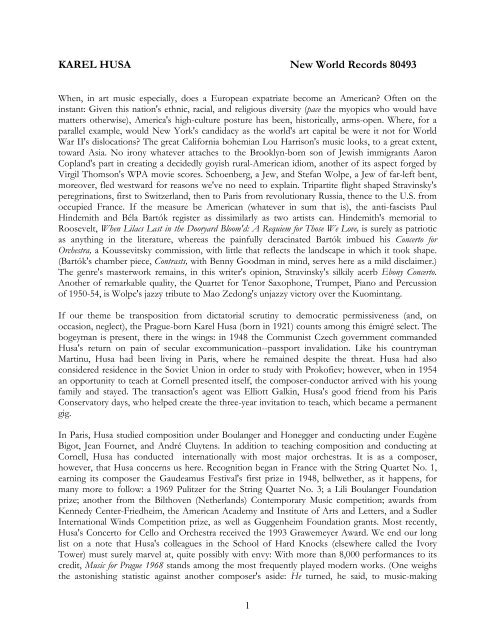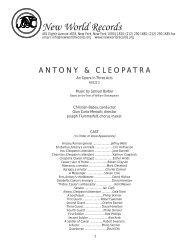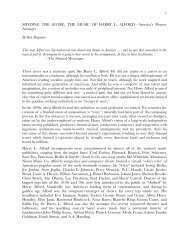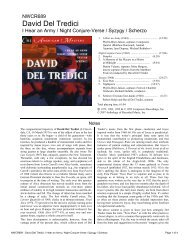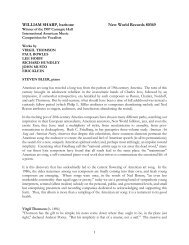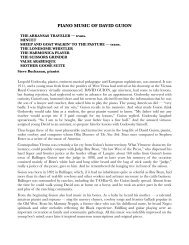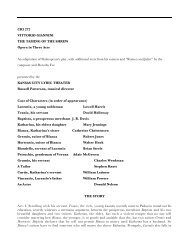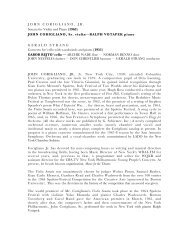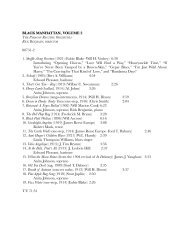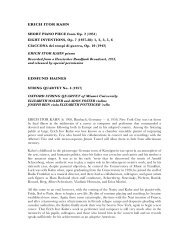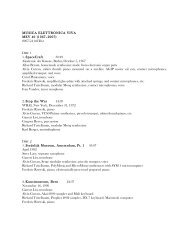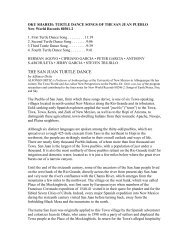KAREL HUSA New World Records 80493
KAREL HUSA New World Records 80493
KAREL HUSA New World Records 80493
Create successful ePaper yourself
Turn your PDF publications into a flip-book with our unique Google optimized e-Paper software.
<strong>KAREL</strong> <strong>HUSA</strong> <strong>New</strong> <strong>World</strong> <strong>Records</strong> <strong>80493</strong><br />
When, in art music especially, does a European expatriate become an American? Often on the<br />
instant: Given this nation's ethnic, racial, and religious diversity (pace the myopics who would have<br />
matters otherwise), America's high-culture posture has been, historically, arms-open. Where, for a<br />
parallel example, would <strong>New</strong> York's candidacy as the world's art capital be were it not for <strong>World</strong><br />
War II's dislocations? The great California bohemian Lou Harrison's music looks, to a great extent,<br />
toward Asia. No irony whatever attaches to the Brooklyn-born son of Jewish immigrants Aaron<br />
Copland's part in creating a decidedly goyish rural-American idiom, another of its aspect forged by<br />
Virgil Thomson's WPA movie scores. Schoenberg, a Jew, and Stefan Wolpe, a Jew of far-left bent,<br />
moreover, fled westward for reasons we've no need to explain. Tripartite flight shaped Stravinsky's<br />
peregrinations, first to Switzerland, then to Paris from revolutionary Russia, thence to the U.S. from<br />
occupied France. If the measure be American (whatever in sum that is), the anti-fascists Paul<br />
Hindemith and Béla Bartók register as dissimilarly as two artists can. Hindemith's memorial to<br />
Roosevelt, When Lilacs Last in the Dooryard Bloom'd: A Requiem for Those We Love, is surely as patriotic<br />
as anything in the literature, whereas the painfully deracinated Bartók imbued his Concerto for<br />
Orchestra, a Koussevitsky commission, with little that reflects the landscape in which it took shape.<br />
(Bartók's chamber piece, Contrasts, with Benny Goodman in mind, serves here as a mild disclaimer.)<br />
The genre's masterwork remains, in this writer's opinion, Stravinsky's silkily acerb Ebony Concerto.<br />
Another of remarkable quality, the Quartet for Tenor Saxophone, Trumpet, Piano and Percussion<br />
of 1950-54, is Wolpe's jazzy tribute to Mao Zedong's unjazzy victory over the Kuomintang.<br />
If our theme be transposition from dictatorial scrutiny to democratic permissiveness (and, on<br />
occasion, neglect), the Prague-born Karel Husa (born in 1921) counts among this émigré select. The<br />
bogeyman is present, there in the wings: in 1948 the Communist Czech government commanded<br />
Husa's return on pain of secular excommunication--passport invalidation. Like his countryman<br />
Martinu, Husa had been living in Paris, where he remained despite the threat. Husa had also<br />
considered residence in the Soviet Union in order to study with Prokofiev; however, when in 1954<br />
an opportunity to teach at Cornell presented itself, the composer-conductor arrived with his young<br />
family and stayed. The transaction's agent was Elliott Galkin, Husa's good friend from his Paris<br />
Conservatory days, who helped create the three-year invitation to teach, which became a permanent<br />
gig.<br />
In Paris, Husa studied composition under Boulanger and Honegger and conducting under Eugène<br />
Bigot, Jean Fournet, and André Cluytens. In addition to teaching composition and conducting at<br />
Cornell, Husa has conducted internationally with most major orchestras. It is as a composer,<br />
however, that Husa concerns us here. Recognition began in France with the String Quartet No. 1,<br />
earning its composer the Gaudeamus Festival's first prize in 1948, bellwether, as it happens, for<br />
many more to follow: a 1969 Pulitzer for the String Quartet No. 3; a Lili Boulanger Foundation<br />
prize; another from the Bilthoven (Netherlands) Contemporary Music competition; awards from<br />
Kennedy Center-Friedheim, the American Academy and Institute of Arts and Letters, and a Sudler<br />
International Winds Competition prize, as well as Guggenheim Foundation grants. Most recently,<br />
Husa's Concerto for Cello and Orchestra received the 1993 Grawemeyer Award. We end our long<br />
list on a note that Husa's colleagues in the School of Hard Knocks (elsewhere called the Ivory<br />
Tower) must surely marvel at, quite possibly with envy: With more than 8,000 performances to its<br />
credit, Music for Prague 1968 stands among the most frequently played modern works. (One weighs<br />
the astonishing statistic against another composer's aside: He turned, he said, to music-making<br />
1
computers mostly in order to hear his stuff. Attempting to line up performers and performances led<br />
him nowhere in the main, a drought worsened still by fast-dehydrating funding.)<br />
With Music for Prague 1968 betokening Husa's European lifeline, we have a significant number of<br />
works that celebrate, wordlessly or as settings of prose and poetry, the composer's adopted land: An<br />
American Te Deum; Cantata, to lines by Whitman, Dickinson, and Edward Arlington Robinson; a<br />
piece for chamber orchestra, Cayuga Lake; Every Day and There Are From Time to Time Mornings, for a<br />
cappella chorus, to words by Thoreau. With regard to the question of roots (in a nation where<br />
attachments are better characterized as rhizomatous), Twelve Moravian Songs from 1955 came to<br />
completion in Ithaca, <strong>New</strong> York, their initial motivation tracing to Europe some few years before: A<br />
German editor had requested easy pieces for school use. In the composer's words: "The result was a<br />
series of moderately difficult scores, including Twelve Moravian Songs. Moravia is a small province in<br />
central Czechoslovakia which nurtured many excellent folk poets and musicians, most of them<br />
unknown to us today. However, they were very adept in their craft; in terms of melody, form, and<br />
construction, they were impeccable. I have in no way altered the texts and only very sparingly<br />
changed melodic contours. The piano parts are entirely mine. At the time of composition I was not<br />
aware that Janácek had used some of the texts." The listener is grateful for the remark regarding the<br />
piano's relationship to that of the soprano; indeed, Husa appears to toss it out as a clue: While the<br />
vocalist meanders among sylvan vistas of a particularly direct and domesticated charm, the piano<br />
looks toward challenging terrain, but never so directly as to surrender its place to mere gestures of<br />
show.<br />
Pianist André-Michel Schub commissioned Sonata No. 2 of 1975, which Husa composed, again in<br />
Ithaca, for the Washington Performing Arts Society's Bicentennial Piano series. Schub gave the<br />
work's première in Washington, D.C.'s John F. Kennedy Center for the Performing Arts in 1975. As<br />
Husa describes it, Sonata No. 2 "is in three movements, reminiscent of the classical sonata form.<br />
This similarity lies mostly in the contrasts of the movements, the first being fast, with a slow<br />
introduction. Otherwise, the composition is written in a virtuosic style, [and] uses twentieth-century<br />
language: new sonorities . . . in the highest and lowest registers and softest and loudest passages.<br />
There is extensive use of pedals, especially the sostenuto, as well as some playing inside the piano, all<br />
in often strongly contrasting sounds. Nevertheless, these are only tools with which I tried to convey<br />
some of my present ideas and feelings."<br />
To engage purposefully with art music's legacy, which is what every living composer must do (each<br />
in and on his or her terms), is a task that approaches the Sisyphean, as effort and reward. In speaking<br />
of his Sonata for Violin and Piano, Husa describes the labor in rather more hopeful terms: "It is<br />
difficult to add something new, unusual and, hopefully, significant. . . . Yet, newer ways always arise.<br />
. . . I have tried . . . to preserve the sonata form by contrasting movements, expanding and<br />
contrasting ideas within the movements, along with the soloistic character of each instrument. I also<br />
wanted to include some of the virtuoso techniques of the old school, such as different ‘jeté’<br />
bowings, left-hand pizzicato, double-stops, harmonics, and so on. When I studied the violin as a<br />
young boy these techniques fascinated me. At the same time, there are some new, equally<br />
fascinating, and characteristic present-day sounds for the violin: sliding tones producing space-like<br />
effects, quarter-tones, short and fast repeated figures reminiscent of bird calls; and for the piano, the<br />
implementation of clusters and extreme high and low registers and inside-the-piano plucking.<br />
"The first movement is moderately fast and free, a dramatic recitative; the second movement<br />
resembles a slow aria; the Interlude explores constant repetition of a high note; the last movement,<br />
2
following without interruption, is a fast and frantic toccata. Both parts, violin and piano, are of equal<br />
importance as in the classical sonata form, but differ from tradition in that they operate more<br />
independently, one from the other." Composed on the shores of <strong>New</strong> York's Lake Cayuga, the<br />
Sonata for Violin and Piano of 1972-73 was a Koussevitsky Foundation commission which received<br />
its premiere in April of '74. "Perhaps this music has been involuntarily influenced by events of the<br />
recent past: continuous warfare, the senseless destruction of nature and animals and, on the other<br />
hand, man's incredible accomplishments in space."<br />
The composer adds these thoughts for the present release:<br />
"Many years have passed since I wrote the Sonata for Violin and Piano and the Sonata No. 2<br />
for Piano. At the time I was interested in exploring ‘new’ techniques, sounds, and forms. It<br />
seemed--and still does--that our performers' technique and musicianship grow more and<br />
more dazzling, although there have been incredible virtuosos in the past, too. Paganini,<br />
Wieniawski, Liszt, just to name a few, wrote music that is difficult to perform even today.<br />
"Both my sonatas try to renew old forms with today's materials. Each period brings new<br />
ideas and possibilities characteristic to their time. Not that all of today's music need be<br />
virtuosic, but, as in the past, composers wish to challenge performers, and performers can<br />
then demonstrate their technique in addition to their artistry.<br />
"While we may use the same subject matter over the centuries, each period will construct it<br />
differently. Take Orpheus: between the Greeks, Monteverdi, Gluck, Offenbach, Stravinsky<br />
and Cocteau, many technical differences exist, but the idea remains the same.<br />
"On the other hand, my Twelve Moravian Songs are the pure preservation of the beautiful<br />
folklore I have known and admired all my life. To the simple, emotional, poetic vocal line<br />
(only rarely altered), I have added only a simple piano part."<br />
—Mike Silverton<br />
Mike Silverton writes about contemporary art music for Fanfare and The Absolute Sound. Mr. Silverton's<br />
poetry has appeared in Harper's, The Nation, Prairie Schooner, Chelsea, and other general-interest and<br />
literary periodicals. He has produced poetry readings for the <strong>New</strong> School for Social Research, <strong>New</strong> York City's then<br />
municipal station WNYC, and the Pacifica Foundation's WBAI, KPFA, and KPFK.<br />
Producer's Reminiscences:<br />
An embarassment of riches was my principal problem. Most of the takes were amazing in that one<br />
was better than the next. To choose one was nit-picking on the highest level. The primary artists,<br />
Elmar Oliveira, Peter Basquin, and Barbara Martin, are all masters with impeccable standards and<br />
their supporting artists David Oei and Elizabeth Rodgers are, in their own right, first-rate.<br />
The sessions were relatively easy; due to the gregariousness of the players we had a lot of fun, with<br />
warmth, love, respect, and a great deal of admiration for each other. The outtakes would be Hall of<br />
Fame material in spite of the deleted expletives.<br />
Karel Husa remains to this date a dear and valued friend, and one of the most charming and<br />
delightful of men. His playful sense of humor continues to be a most enjoyed part of our friendship.<br />
3
He did not attend any of the sessions, although he was always available for consultations and runthroughs<br />
with the artists. <strong>New</strong> <strong>World</strong> <strong>Records</strong> should be praised for this reissue, as it brings together<br />
some wonderful music by a modern master.—Richard Gilbert, September 30, 1995<br />
Peter Basquin, piano, studied with William Nelson at Carleton College and with Dora Zaslavsky at<br />
the Manhattan School of Music, where he received the Master of Music degree. He has performed<br />
with the orchestras of Boston, Minnesota, and Montreal, among others, and presented premières of<br />
major contemporary works with the Long Island Chamber Ensemble of <strong>New</strong> York. Mr. Basquin has<br />
specialized in the solo repertory of the nineteenth and twentieth centuries, including Lizst's Paganini<br />
Etudes, Schumann's Etudes Symphoniques, and Stravinsky's Petrouchka. He has recorded for Grenadilla<br />
and <strong>New</strong> <strong>World</strong> <strong>Records</strong>.<br />
Barbara Ann Martin, soprano, winner of the 1982 Concert Artist's Guild Award, has been soloist<br />
with the <strong>New</strong> York, Berlin, and Vienna Philharmonics and the Montreal Symphony. Her opera<br />
appearances include the Metropolitan Opera and the Lyric Opera of Chicago. Ms. Martin has<br />
performed and recorded works by Dominick Argento, Milton Babbitt, Alan Hovhaness, Louise<br />
Talma, Chinary Ung, and others. She has also performed the works of George Crumb, Sofia<br />
Gubaidulina, and Gyorgy Kurtag. Ms. Martin has recorded for CRI, Musical Heritage, Pantheon,<br />
and Grenadilla <strong>Records</strong>.<br />
David Oei, piano, has appeared as soloist with the <strong>New</strong> York Philharmonic and the Pittsburgh and<br />
Baltimore symphonies, and as a guest artist with the St. Luke's and Orpheus Chamber Ensembles,<br />
Bargemusic, and the Chamber Music Society of Lincoln Center. An original member of the Aspen<br />
Soloists and "The Intimate P.D.Q. Bach," he has participated in the Caramoor, Seattle, and<br />
Chamber Music Northwest Festivals, and recorded for Vanguard and Grenadilla <strong>Records</strong>.<br />
Elmar Oliveira, violin, was eleven years old when he went to the Hartt College of Music to study<br />
with Ariana Bronne and her father, Raphael Bronstein. Winning his first competition at age 14,<br />
Oliveira made his orchestral debut that same year (1964) with the Hartford Symphony. In 1966 he<br />
was chosen by Leonard Bernstein to appear as soloist with the <strong>New</strong> York Philharmonic for a<br />
nationally televised Young People's Concert. Mr. Oliveira has performed with the <strong>New</strong> York<br />
Philharmonic, the Los Angeles Philharmonic, the symphony orchestras of Atlanta, Boston, Chicago,<br />
Detroit, Dallas, Milwaukee, Minnesota, Pittsburgh, and San Francisco, the Leipzig Gewandhaus<br />
Orchestra, the Zurich Tonhalle Orchestra, and the London Philharmonic Orchestra. He has toured<br />
the Far East, South America, Australia, and the former Soviet Union. In addition to playing the<br />
standard violin literature, Mr. Oliveira has premiered works by contemporary composers such as<br />
Joan Tower, Ezra Laderman, Morton Gould, Andrzej Panufnik, and Hugh Aitkin, and has recorded<br />
works by Barber and Bartók. He has recorded for Angel, CBS Masterworks, Vox, Delos, Grenadilla,<br />
Melodiya, Elan, First Edition, and Pickwick Classics.<br />
Elizabeth Rodgers, piano, holds degrees from the Manhattan School of Music, where she studied<br />
piano with Dora Zaslavsky, and chamber music with Lillian Fuchs, David Wells, and Benar Heifetz.<br />
She earned critical acclaim performing as accompanist to the distinguished soprano Judith Raskin.<br />
She has appeared with, among other groups, the Philadelphia Composers' Forum, Infusion,<br />
<strong>New</strong>band, and Contemporary Concerts at Columbia University. Ms. Rodgers has premiered works<br />
by such composers as Marc-Antonio Consoli and Miriam Gideon. She has recorded for Opus One<br />
and CRI.<br />
4
TWELVE MORAVIAN SONGS<br />
English translation of Moravian texts by Ruth Martin<br />
Sunrise<br />
There is the sun climbing the skies,<br />
There is the sun climbing bright skies.<br />
My dearest love open your eyes,<br />
O, come, my dearest love,<br />
Open your eyes.<br />
Till you are here, sad is my heart,<br />
Till you are here, sad is my heart.<br />
Hurry to me, never to part,<br />
O, come! Hurry to me, never to part.<br />
Who Is That?<br />
Who is that all alone walking along the dam?<br />
It is a dark-eyed girl planting sweet marjoram.<br />
Spring is the time to sow, now it's too late to start.<br />
Why did you let her go? Why did you break her heart?<br />
The Deserter<br />
I deserted from the army,<br />
But some soldiers caught me quickly,<br />
Then they asked "From where do you come?<br />
Soldier, tell us where's your home?"<br />
I'm a loyal son of Moravia,<br />
All I love is in Moravia.<br />
There tomorrow I must be,<br />
There my sweetheart waits for me.<br />
Between Two Mountains<br />
Down between two mountains in the lovely valley,<br />
There I met my sweetheart looking very angry.<br />
Then he began weeping<br />
And his tears were flowing on the stones beneath him<br />
While his rage was growing.<br />
"Darling, don't be angry, come let's stroll together.<br />
Saturday, I promise,<br />
You shall have this feather."<br />
When I Sing<br />
High up in the mountains my song echoes clearly.<br />
Down there in the stable my sweetheart can hear me.<br />
5
He says to his father: "O please listen to my love!<br />
How sweet is her singing on the mountain above."<br />
What Is Wrong?<br />
O Jan, what is wrong? You have plowing to do!<br />
Are your oxen just too lazy, or can it be you?<br />
Marie, don't you know that I want to plow,<br />
But I need your love to cheer me and I need it now.<br />
Song for Dancing<br />
If the farmer did not have such a pretty daughter,<br />
There'd not be so many boys around to court her,<br />
There'd not be so many boys around to court her.<br />
If the farmer had gates of steel, gates of steel from Steyer,<br />
I would still jump over,<br />
Were they ten times higher, I would still jump over,<br />
Were they ten times higher.<br />
Echo in the Mountains<br />
Ah, mountains so green all bathed in gold morning light,<br />
all bathed in gold morning light.<br />
Say, when day is done who will I find waiting here?<br />
Who will kiss my lips tonight?<br />
The Snowball<br />
Why, dear snowball, do you lie there in the river?<br />
Does the thought of springtime make you shiver?<br />
No, I'm not scared of springtime, nor of sunshine<br />
nor of dry land.<br />
I was born of water, this is my land.<br />
Aspen Leaves<br />
When the leaves fade on the aspen tree one fall day,<br />
They just flutter to the ground and then the wind will<br />
blow them away,<br />
When the time comes, when the golden years are ending,<br />
Shall I also like the aspen leaves grow faded and<br />
unbending?<br />
Dear beloved, dear beloved, hear me, come what may:<br />
Never let our love grow faded,<br />
Rather let it flutter away.<br />
Lost Love<br />
6
Love was once alive and glowing, then it fled in secret going,<br />
leaving not a trace behind it.<br />
Deep beneath a stone it's hidden, lying lonely<br />
and unbidden<br />
There where no one thinks to find it.<br />
Homeland, Goodbye<br />
When the Slovak set off to roam one fine day,<br />
High on the hill we heard him cry, on his way:<br />
"Father of mine, Mother so dear, Hear me call!<br />
Sister I love and brother, too, Good-bye all!"<br />
"Tell me truly, when I return, dear old hill,<br />
shall I find you, steadfast and true,<br />
Waiting still?<br />
When I come home, where will my dear mother be?<br />
When I return<br />
Will my beloved still love me?<br />
SELECTED DISCOGRAPHY<br />
Apotheosis of this Earth, for Orchestra and Chorus; Monodrama. Louisville Orchestra, Karel Husa<br />
conducting. Louisville Orchestra First Edition Recordings LCD 005.<br />
Concerto for Orchestra. Saint Louis Symphony, Leonard Slatkin conducting. Limited Edition CD.<br />
Concerto for Percussion and Wind Ensemble. Moscow Philharmonic, Dmitri Kitayenko<br />
conducting. Sheffield Salon<br />
Series (CD) SLS 506.<br />
Divertimento for Brass Ensemble; Fantasies for Orchestra; scenes from The Trojan Women. <strong>New</strong><br />
York Brass Ensemble, Lawrence Sobol conducting. Les Solistes de Paris, Brno<br />
Philharmonic, Karel Husa conducting. Phoenix PHCD 128.<br />
Elegie et Rondeau. Lawrence Gwozdz, saxophone; David Evenson, piano. Crystal <strong>Records</strong> DCD 652.<br />
Music for Prague 1968. Eastman Wind Ensemble, Donald Husberger conducting. CBS Masterworks<br />
(CD) MK 44916.<br />
Music for Prague 1968 (orchestral version). Bohuslav Martinu Philharmonic Orchestra, Milos Machek<br />
conducting. Vienna Modern Masters (CD) MN 3023.<br />
Music for Prague 1968; Reflections (Symphony No. 2); Fresque. Slovak Radio Symphony Orchestra, Barry<br />
Kolman conducting. Marco Polo (CD) 8223640.<br />
Serenade for Woodwind Quintet and Piano. Westwood Wind Quintet; Lisa Berman, piano. Crystal<br />
<strong>Records</strong> (CD) 751.<br />
Sonata a Tre for violin, clarinet, and piano. Verdehr Trio. Crystal <strong>Records</strong> DCD 744.<br />
String Quartets Nos. 2 and 3; Evocations of Slovakia. Fine Arts Quartet, Long Island Chamber<br />
Ensemble, Lawrence Sobol conducting. Phoenix PHCD 113.<br />
Symphony No. 1; Serenade; Mosaiques; Landscapes. Prague Symphony Orchestra, Stockholm<br />
Symphony Orchestra, Karel Husa conducting. Western Brass Quintet. CRI CD 592.<br />
Three Dance Sketches for Percussion. Prague Percussion Project. Rotag (CD) RG 0019-2131.<br />
The Trojan Women. Louisville Orchestra, Akira Endo conducting. Louisville <strong>Records</strong> (LP) LS 755.<br />
Two Sonnets by Michaelangelo. Louisville Orchestra, Jorge Mester conducting. Louisville <strong>Records</strong> (LP)<br />
LS 725.<br />
7
SELECTED BIBLIOGRAPHY<br />
Ewen, D. Composers since 1900. First Supplement, <strong>New</strong> York: H. W. Wilson, 1981.<br />
Fleming, S. "Musician of the Month." Musical America, August 1969.<br />
Galkin, E. W. "<strong>New</strong> York Philharmonic: Concerto for Orchestra." Musical America, March 1987.<br />
Haitchcock, M. "Karel Husa Talks About Composing." The Instrumentalist, April 1982.<br />
Hartzell, L. "Karel Husa: The Man and the Music." Musical Quarterly, January 1976.<br />
Hegvik, A. "Meet the Composer: Karel Husa--Apotheosis of This Earth." The Instrumentalist, October<br />
1975.<br />
Ianncone, A. "Karel Husa: A Composer for His Time and Beyond." Cross Currents: A Yearbook of<br />
Central European Culture, 1988.<br />
Ledec, J. "Composer Karel Husa Returns." MadAminA, Fall 1993.<br />
Perlis, V. "Karel Husa Is Home Again." Musical America, September 1990.<br />
Sturm, G. "Karel Husa." MadAminA, Spring 1981.<br />
----. "Music for Prague Performed in Prague at Last." MadAminA, Spring 1990.<br />
----. "1993 Grawemeyer Award Presented to Karel Husa." MadAminA, Fall 1993.<br />
Producer: Richard Gilbert<br />
Engineer: Greg Deutsch (Sonata for Violin and Piano); Marc Aubort and Joanna Nickrenz/Elite<br />
Recordings, Inc. (Sonata No. 2); David Avidor (Twelve Moravian Songs)<br />
Sonata for Violin and Piano was recorded at Right Track Recordings, NYC. Sonata No. 2 was<br />
recorded at Rutgers Presbyterian Church, NYC. Twelve Moravian Songs was recorded at Sorcerer<br />
Sounds, NYC.<br />
Digital mastering: Carl Talbot, Classic Sound Inc., NYC<br />
Cover design: Bob Defrin Design, Inc., NYC<br />
Sonata for Violin and Piano is from Grenadilla GS-1032, Sonata No. 2 is from Grenadilla GS-1025,<br />
and Twelve Moravian Songs is from Grenadilla GSC-1073.<br />
The original recording of Twelve Moravian Songs was made possible by grants from the<br />
National Endowment for the Arts and the Guild for Contemporary Music<br />
This recording was made possible with grants from the National Endowment for the Arts,<br />
the <strong>New</strong> York State Council on the Arts, and Francis Goelet<br />
FOR NEW WORLD RECORDS:<br />
Herman E. Krawitz, President; Paul Marotta, Managing Director; Paul M. Tai, Director of Artists<br />
and Repertory; Lisa Kahlden, Director of Information Technology; Virginia Hayward,<br />
Administrative Associate; Mojisola Oké, Bookkeeper; Ben Schmich, Productions Associate.<br />
RECORDED ANTHOLOGY OF AMERICAN MUSIC, INC., BOARD OF TRUSTEES:<br />
David Hamilton, Treasurer; Milton Babbitt; Emanuel Gerard; Adolph Green; Rita Hauser; Herman<br />
E. Krawitz; Arthur Moorhead; Elizabeth Ostrow; Don Roberts; Patrick Smith; Frank Stanton.<br />
Francis Goelet (1926-1998), Chairman<br />
1978, 1988 ©1995 Recorded Anthology of American Music, Inc. All rights reserved. Printed in<br />
USA.<br />
8
<strong>KAREL</strong> <strong>HUSA</strong> (b. 1921) <strong>80493</strong>-2<br />
Sonata for Violin and Piano (1972-73)<br />
1 Movement I (9:05)<br />
2 Movement II (12:34)<br />
3 Interlude (3:32)<br />
4 Movement III (9:32)<br />
Elmar Oliveira, violin; David Oei, piano<br />
Sonata No. 2 for Piano (1975)<br />
5 Movement I (5:39)<br />
6 Movement II (6:26)<br />
7 Movement III (7:18)<br />
Peter Basquin, piano<br />
Twelve Moravian Songs (1955)<br />
8 Sunrise (1:41)<br />
9 Who Is That? (0:55)<br />
10 The Deserter (0:54)<br />
11 Between Two Mountains (1:48)<br />
12 When I Sing (1:18)<br />
13 What Is Wrong? (0:49)<br />
14 Song for Dancing (0:37)<br />
15 Echo in the Mountains (1:10)<br />
16 The Snowball (1:20)<br />
17 Aspen Leaves (0:42)<br />
18 Lost Love (1:05)<br />
19 Homeland, Goodbye (2:04)<br />
Barbara Martin, soprano; Elizabeth Rodgers, piano<br />
All compositions published by Associated Music Publishers (BMI)<br />
NO PART OF THIS RECORDING MAY BE COPIED OR REPRODUCED WITHOUT<br />
WRITTEN PERMISSION OF R.A.A.M., INC.<br />
NEW WORLD RECORDS<br />
16 Penn Plaza #835<br />
NEW YORK, NY 10001-1820<br />
TEL 212.290-1680 FAX 212.290-1685<br />
Website: www.newworldrecords.org<br />
email: info@newworldrecords.org<br />
LINER NOTES Recorded Anthology of American Music, Inc.<br />
9


